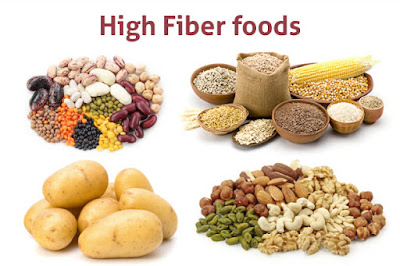How High Fiber Foods Help To Lose Weight?
The concept of high fibre foods comes with a baggage of myths which must be busted. Besides, it is vital to classify fibres to know which ones are truly beneficial.
Fibres are defined as nutrients which are essentially resistant to the actions of the digestive elements. Both soluble and insoluble fibres are equally beneficial upon human consumption.
However, to deal with it more effectively, it only fits to probe specifically.
It is vital to keep in mind that not all fibres are agents of weight loss. One should focus only on the viscous type.
Viscous fibres occur extensively in plants such as oats, legumes, flax seeds and asparagus among other things. However, it is equally vital to keep in mind that fibre intake should not be increased abruptly or else it might result in cramps and abdominal discomfort.
Over a hundred trillion bacteria are estimated to be found in the gut itself. Known as gut flora, these friendly bacteria are an important element in the digestive process. For instance, their prolixity helps the proper functioning of the brain, control the levels of blood sugar and address immunity. Bacteria secrete fatty acids to assimilate fibres.
Essentially, these friendly bacteria must derive their nutrients from fibres to survive. Specifically speaking, these organisms need soluble fibres for their survival, which pas easily through the gut to reach the bacteria that turn them into energy.
Technically, these soluble fibres which are vital for the functioning of the body are known as known as fermentable fibres. At the same time, there certain insoluble fibres such as starch, which are equally effective for the digestive system.
Also, bacteria (Lactobacilli) help prevent what is known as the leaky gut syndrome in which gaps crop up between intestinal cells.
According to studies carried out over the years, it has been found that the amount of fibre intake is inversely proportional to the intensity of chronic gut inflammation.
The importance of high fibre intake, therefore, cannot be overemphasised. Additionally, gut bacteria have been found to resist the production of trimethylamine N-oxide which contribute to heart disorders.
FAQ
1) Are all fibres equally beneficial for the body?
No, only viscous fibres are the essential fibres.
2) Do fibres affect inflammation?
It has been found that high fibre intake considerably reduces the chances of gut inflammation.
3) Are insoluble fibres any good?
Only certain ones such as starch are advisable.
Read More To Follow the Link : https://truweight.in/blog/nutrition/high-fiber-foods-help-weight-loss.html
Fibres are defined as nutrients which are essentially resistant to the actions of the digestive elements. Both soluble and insoluble fibres are equally beneficial upon human consumption.
Introduction
Thanks to considerable research, it is almost common sense that high fibre stuff helps one to shed extra skin.However, to deal with it more effectively, it only fits to probe specifically.
It is vital to keep in mind that not all fibres are agents of weight loss. One should focus only on the viscous type.
Viscous fibres occur extensively in plants such as oats, legumes, flax seeds and asparagus among other things. However, it is equally vital to keep in mind that fibre intake should not be increased abruptly or else it might result in cramps and abdominal discomfort.
Fibre Helps Good Bacteria to Proliferate
By causing gels to form in the gastrointestinal tract, the action of soluble fibre can be judged by its effect upon the FI. Delayed digestion and assimilation through gastric distension are essential processes for weight loss. Insoluble fibre boosts SCFA production and the secretion of incretins which reduce FI and increase satiety.Over a hundred trillion bacteria are estimated to be found in the gut itself. Known as gut flora, these friendly bacteria are an important element in the digestive process. For instance, their prolixity helps the proper functioning of the brain, control the levels of blood sugar and address immunity. Bacteria secrete fatty acids to assimilate fibres.
Essentially, these friendly bacteria must derive their nutrients from fibres to survive. Specifically speaking, these organisms need soluble fibres for their survival, which pas easily through the gut to reach the bacteria that turn them into energy.
Technically, these soluble fibres which are vital for the functioning of the body are known as known as fermentable fibres. At the same time, there certain insoluble fibres such as starch, which are equally effective for the digestive system.
Gut Bacteria
Gut bacteria are especially significant in that they help resist chronic inflammation. Apart from that, these microorganisms are equally beneficial in that they produce essential nutrients for the functioning of the digestive system.Also, bacteria (Lactobacilli) help prevent what is known as the leaky gut syndrome in which gaps crop up between intestinal cells.
According to studies carried out over the years, it has been found that the amount of fibre intake is inversely proportional to the intensity of chronic gut inflammation.
The importance of high fibre intake, therefore, cannot be overemphasised. Additionally, gut bacteria have been found to resist the production of trimethylamine N-oxide which contribute to heart disorders.
Conclusion
Given the large scale benefits of high fibre foods, it is essential to make viscous fibres a major part of consumption.FAQ
1) Are all fibres equally beneficial for the body?
No, only viscous fibres are the essential fibres.
2) Do fibres affect inflammation?
It has been found that high fibre intake considerably reduces the chances of gut inflammation.
3) Are insoluble fibres any good?
Only certain ones such as starch are advisable.
Read More To Follow the Link : https://truweight.in/blog/nutrition/high-fiber-foods-help-weight-loss.html





Comments
Post a Comment